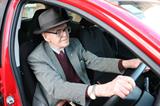The ageing process and driver safety
With an increase in life expectancy comes an increase in the proportion of older drivers. Various crash studies and surveys have shown that older drivers are particularly over-represented in crashes at intersections, where typically the older driver turns against oncoming traffic with right of way on the main road. This study aimed to investigate the correlation between ‘failed to look’ errors, which previous studies have identified as a key factor in crashes involving older drivers, and visuo-cognitive deficits. The first phase of the study reviewed relevant literature to provide a background to the cognitive and visual measures used. The second phase of the study included simulator and laboratory based tests of visual and cognitive performance, in general and when driving. The study demonstrated that older drivers tend to have reduced visual capabilities. In many respects, their experience enables them to compensate for these deficiencies. However, some specific changes in behaviour were observed that seem strongly linked to the tendency for older drivers to be over-represented in ‘failed to look’ accidents. Support for older drivers to improve performance through training and/or support technologies may help to tackle this problem, although any intervention would require evaluation and validation of effectiveness.

